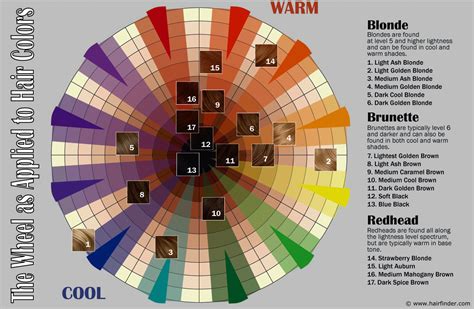Introduction
The hair color wheel is an indispensable tool for hair stylists and beauty enthusiasts alike. It provides a systematic way to organize and understand the relationships between different hair colors. By understanding the color theory behind the hair color wheel, stylists and clients can create personalized, harmonious hair looks.

The 7 Key Shades
The hair color wheel consists of seven key shades:
- Primary Colors: Red, Yellow, Blue
- Secondary Colors: Green, Orange, Purple
- Tertiary Colors: Warm Browns, Cool Browns
Color Theory and the Hair Color Wheel
The hair color wheel is based on the color theory principles of color relationships. These relationships are:
- Complementary Colors: Colors opposite each other on the wheel (e.g., red and green, blue and orange) create contrast and vibrancy.
- Analogous Colors: Colors adjacent to each other on the wheel (e.g., red, orange, and yellow) create a harmonious and cohesive look.
- Triadic Colors: Colors evenly spaced around the wheel (e.g., red, yellow, and blue) create a striking and balanced effect.
13 Stunning Hair Color Combinations
Using the hair color wheel, stylists can create an endless range of hair color combinations. Here are 13 popular and visually appealing combinations:
| Combination | Effect |
|---|---|
| Warm Brown with Cool Brown Highlights | Subtle but sophisticated depth and dimension |
| Red with Yellow Highlights | Bold and energetic with a touch of warmth |
| Blue with Green Highlights | Dramatic and unconventional with mermaid-like vibes |
| Purple with Pink Highlights | Soft and feminine with a hint of fantasy |
| Orange with Yellow Highlights | Creative and sunny with a summery feel |
| Red with Purple Highlights | Rich and enigmatic with a touch of elegance |
| Yellow with Purple Highlights | Cheerful and playful with a dash of whimsy |
| Blue with Orange Highlights | Unexpected and eye-catching with a pop of color |
| Green with Purple Highlights | Cool and mysterious with a hint of etherealness |
| Orange with Blue Highlights | Vibrant and unconventional with a touch of the unexpected |
| Red with Green Highlights | Edgy and striking with a touch of sophistication |
| Yellow with Blue Highlights | Bright and energetic with a summery feel |
| Purple with Orange Highlights | Contrasting and complementary with a touch of warmth |
Why the Hair Color Wheel Matters
Understanding the hair color wheel matters for several reasons:
- Personalization: It allows stylists to customize hair colors to suit individual skin tones, eye colors, and desired effects.
- Avoid Color Disasters: It helps stylists avoid color combinations that clash or create unwanted tones.
- Inspiration: It serves as a source of inspiration for creating innovative and flattering hair looks.
Benefits of Using the Hair Color Wheel
Using the hair color wheel offers numerous benefits for both stylists and clients:
- Accurate Color Predictions: It helps stylists predict the exact color outcome based on the client’s current hair color and desired shade.
- Time-Saving: By following the color wheel, stylists can save time by determining the perfect color combinations and minimizing trial and error.
- Client Satisfaction: The hair color wheel empowers clients to make informed decisions about their hair color, leading to higher satisfaction levels.
FAQs
1. Can I use the hair color wheel at home?
- Yes, the hair color wheel can be used as a guide, but it’s recommended to consult with a professional hairstylist for personalized advice.
2. What if I want a color not on the wheel?
- The hair color wheel is a tool, not a limitation. If you desire a color not represented on the wheel, stylists can use their knowledge and creativity to create a custom shade.
3. How do I maintain colored hair?
- To maintain the vibrancy and longevity of colored hair, use color-safe shampoos and conditioners, minimize heat styling, and protect hair from sun exposure.
4. Can I mix different hair color brands?
- While it’s best to stick with one brand for consistency, mixing brands can be done cautiously but should be monitored closely to avoid adverse reactions.
5. How often should I get my hair colored?
- The frequency of hair coloring depends on the individual’s hair growth rate, hair type, and desired color. Consult a hairstylist for personalized recommendations.
6. Can I achieve my desired hair color in one session?
- Depending on the starting color, desired shade, and hair condition, achieving the perfect hair color may require multiple sessions to avoid damage.
7. What is a demi-permanent hair color?
- Demi-permanent hair color deposits color into the hair shaft without ammonia, making it less damaging than permanent color and lasting for several washes.
8. What is a fashion color?
- Fashion colors are semi-permanent or temporary dyes that are used to add vibrant, non-natural hues to hair. They wash out over time.
Conclusion
The hair color wheel is a powerful tool for understanding and creating harmonious hair colors. By embracing its principles, stylists and clients can achieve personalized, flattering, and visually stunning results.
